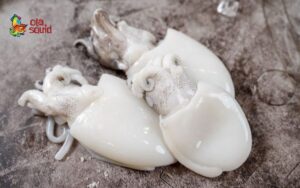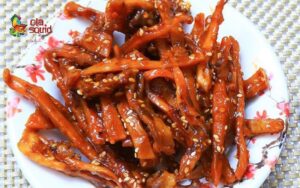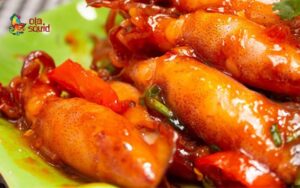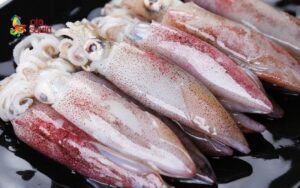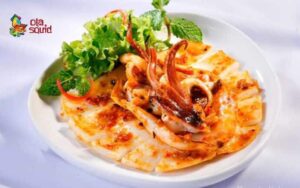In the treasure trove of Vietnamese cuisine, canh măng mực (dried squid and bamboo shoot soup) is a rustic dish that carries a whole sky of memories. The sweet, clear taste from the squid, the slight crispness of the bamboo shoots, all blended in a fragrant broth creates a rich, warm, and truly homeland-flavored soup. If you’re looking for how to cook delicious and authentic canh măng mực, join Ola Squid in the kitchen to cook a true bowl of canh măng mực with the recipe below!
Canh măng mực – a traditional dish imbued with the flavor of home
Canh măng mực is not just a rustic dish for everyday meals but also a symbol of togetherness and warmth during Tết, spring festivals, or traditional ceremonies and anniversaries. Each steaming bowl of soup carries not only the sweet flavor of squid and bamboo shoots but also countless memories of home, of childhood days around the family meal, filled with laughter.

This seemingly simple dish hides meticulousness and refinement in every step. From choosing dried squid to create richness and a characteristic aroma, or using fresh squid for a light sweetness; combined with crisp, sweet fresh bamboo shoots or dried bamboo shoots to suit many people’s tastes.
Regardless of the region, canh măng mực retains its unique, simple yet rich character, a dish that just one spoonful can evoke a familiar, loving feeling. Therefore, this soup is not only about nutritional value but also a spiritual dish – carrying the affection and connection between generations in the family.
Ingredients for preparing canh măng mực
Before starting to cook, we need to prepare the ingredients carefully. Fresh and delicious ingredients are the deciding factor in the success of the dish.
Main Ingredients
- Dried squid or fresh squid (depending on taste): 200-300g
- Fresh or dried bamboo shoots: 200g
- Pork bones (or pork hock if you want a richer broth): 300g
- Shallots, scallions, cilantro
- Seasonings: salt, fish sauce, seasoning powder, pepper, cooking oil

Tips for choosing delicious ingredients
To achieve a rich flavor in your canh măng mực, pay attention to:
- Dried squid: choose thick, firm pieces with a characteristic sea aroma, light pink color. Do not choose squid that is damp or shows signs of mold.
- Bamboo shoots: if using dried bamboo shoots, choose those that have been thoroughly dried, with no strange smell. Fresh bamboo shoots should be young, crisp, and not bitter.
- Pork bones: choose fresh bones, with some meat for a sweeter broth.
How to cook rich and non-fishy canh măng mực
With all ingredients ready, the next step is preparation. To make canh măng mực delicious and authentic, you need to follow the correct sequence and pay attention to every detail.
Step 1: Properly prepare squid and bamboo shoots
- Dried squid: lightly grill to release aroma, then soak in warm water for about 1-2 hours until soft, then shred or cut into bite-sized pieces.
- Fresh squid: clean, make light cuts so the squid absorbs seasoning.
- Dried bamboo shoots: soak overnight, boil multiple times to remove toxins and any bitter smell.
- Fresh bamboo shoots: boil at least 2 times, rinse thoroughly, and shred.

Step 2: Sauté squid and bamboo shoots to release aroma
Sauté shallots until fragrant, add squid and stir-fry quickly until firm, then add bamboo shoots and stir-fry together. Season lightly so the bamboo shoots and squid absorb the flavor, making the soup rich and not bland.
See now: How to make delicious stir-fried squid with bamboo shoots that you shouldn’t miss
Step 3: Simmer the soup to extract sweetness
- Simmer pork bones to get a clear, sweet broth for about 1-2 hours. Skim off any foam regularly to keep the broth clear.
- Add the sautéed squid and bamboo shoots to the broth, continue to simmer for another 30 minutes for the ingredients to meld.
- Adjust seasoning to taste, add chopped scallions and pepper before turning off the heat.
Variations of canh măng mực according to taste
Not limited to a single recipe, canh măng mực can be varied to suit the tastes and culinary styles of different regions. Regardless of changes in ingredients or cooking methods, the soup always retains its traditional essence: sweet, rich, and captivating with every spoonful.
Dried squid soup with pork hock
Canh măng mực khô nấu giò heo (dried squid and bamboo shoot soup with pork hock) is a common dish in Northern Vietnamese feasts, especially during Tet or on cool days. Dried squid, after being lightly grilled and soaked until soft, is stir-fried with well-boiled dried bamboo shoots, then simmered with tender, fatty pork hock. The broth is rich, fragrant, and the sweet, fatty flavor spreads on the palate, making everyone who tastes it sigh with delight. This is one of the richest and most nutritious variations of canh măng mực, perfect for a warm, reunion family meal.

Canh măng mực with tamarind/light sourness
If you are a fan of slightly sour soups, then canh măng mực cooked with sấu (dracontomelon) or tamarind is the version worth trying. The natural light sourness from sấu or tamarind helps balance the richness of the squid and the sweetness of the bone broth, creating a harmonious, easy-to-eat soup that is perfect with rice. This variation is popular in the South or on hot summer days; a bowl of lightly sour soup can awaken both taste buds and spirit.
Each variation of canh măng mực not only reflects regional tastes but also demonstrates creativity and flexibility in Vietnamese culinary art. No matter how it’s cooked, this soup always retains its unique character: the sweet taste from the sea, the crispness of the bamboo shoots, and the connection in every family meal.
Don’t forget to check out How to cook delicious squid noodle soup or Dried squid for soup to enrich your family’s menu with attractive squid dishes, full of homeland flavors.
Frequently Asked Questions
During the process of cooking canh măng mực, many housewives – especially those trying this dish for the first time – often encounter some questions related to ingredients, preservation, or cooking techniques. Here are some common questions and their specific answers to help you feel more confident in the kitchen.
Should dried squid be grilled first or not?
Yes. This is an important step to make the canh măng mực more delicious and flavorful. Grilling dried squid before soaking not only releases its characteristic aroma but also removes the inherent fishy smell of dried seafood. After grilling, you should soak the squid in warm water to soften it and make it easier to cook. Note that you should not grill it too much, as it will make the squid dry, tough, and bitter.

Can canh măng mực be stored for a long time?
Yes, but it should be consumed within a short period. Canh măng mực can be stored in the refrigerator for 1-2 days. However, if the soup contains pork hock, you should consume it within the day to maintain its freshness and avoid absorbing odors. When reheating, bring it to a boil to ensure hygiene and that the flavor is not altered. If stored for longer, the bamboo shoots may become sour and the squid may lose its original chewy texture.
Tips for cooking canh măng mực
To achieve the perfect canh măng mực – light yet rich, fragrant yet not fishy – you should apply a few small tips below. These seemingly simple secrets can make a significant difference in the flavor and quality of the dish.
- Boil bamboo shoots thoroughly multiple times to remove toxins and bitterness: Fresh or dried bamboo shoots may contain natural toxins (cyanide) and a characteristic bitter smell. Boiling 2-3 times, changing the water each time, helps to completely remove the bitter substances and ensure health safety.
- Use bone broth to enhance natural sweetness: Instead of plain water, simmer pork bones or pork hock to make the broth. The broth not only makes the soup sweetly clear and flavorful but also creates a light richness that pairs perfectly with bamboo shoots and squid.
- Add fish sauce at the end to preserve aroma: Adding fish sauce when the soup is almost done helps retain its rich, characteristic aroma. If added too early, the fish sauce aroma will evaporate with the steam, making the dish less appealing.
- Do not simmer squid for too long to avoid toughness: Whether it’s dried or fresh squid, you should only cook it until it’s tender. Overcooked squid will become tough, lose its sweetness, and make the canh măng mực less appealing.
Canh măng mực is a simple dish that contains sophistication in every slice of bamboo shoot, piece of squid, and the care put into every cooking step. Hopefully, through this article, Ola Squid has inspired you to confidently enter the kitchen and cook a bowl of canh măng mực that is not only delicious but also full of affection.


 Tiếng Việt
Tiếng Việt ไทย
ไทย